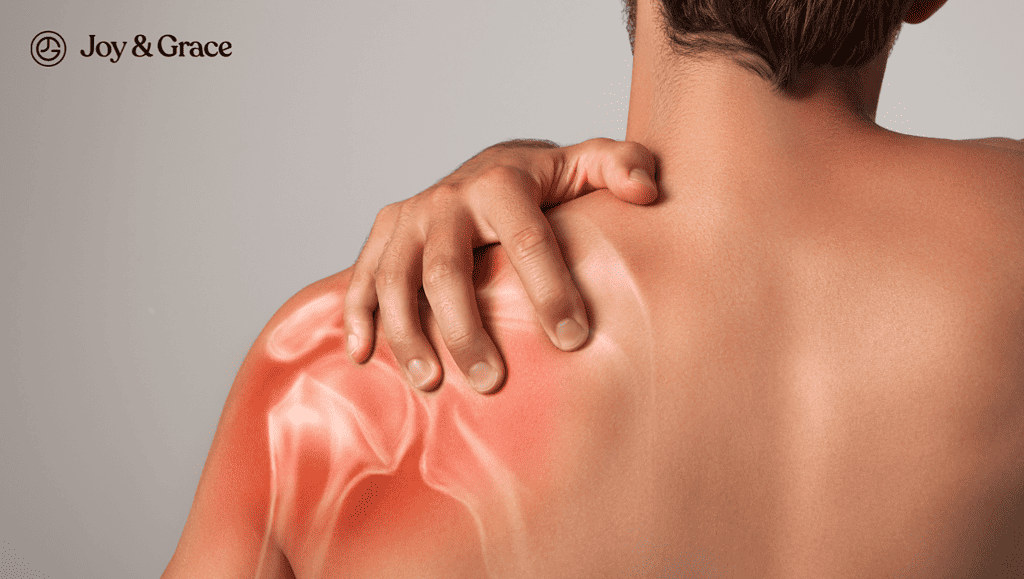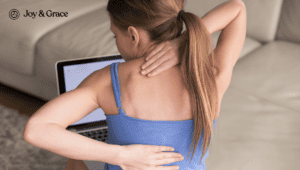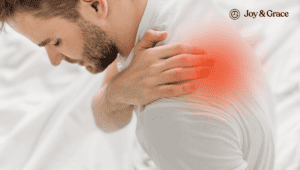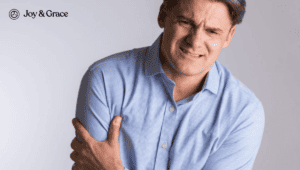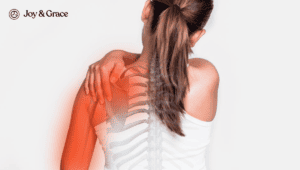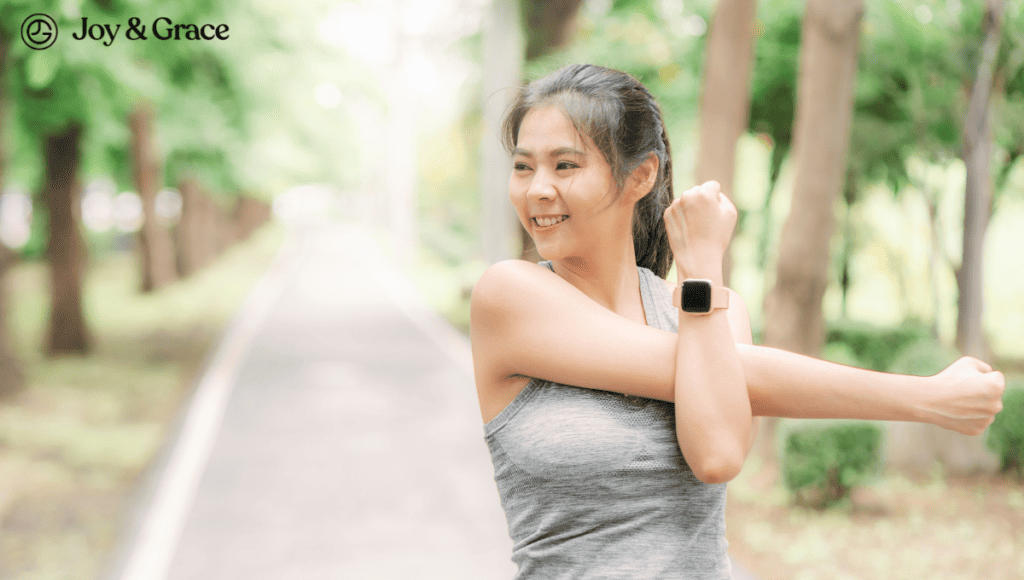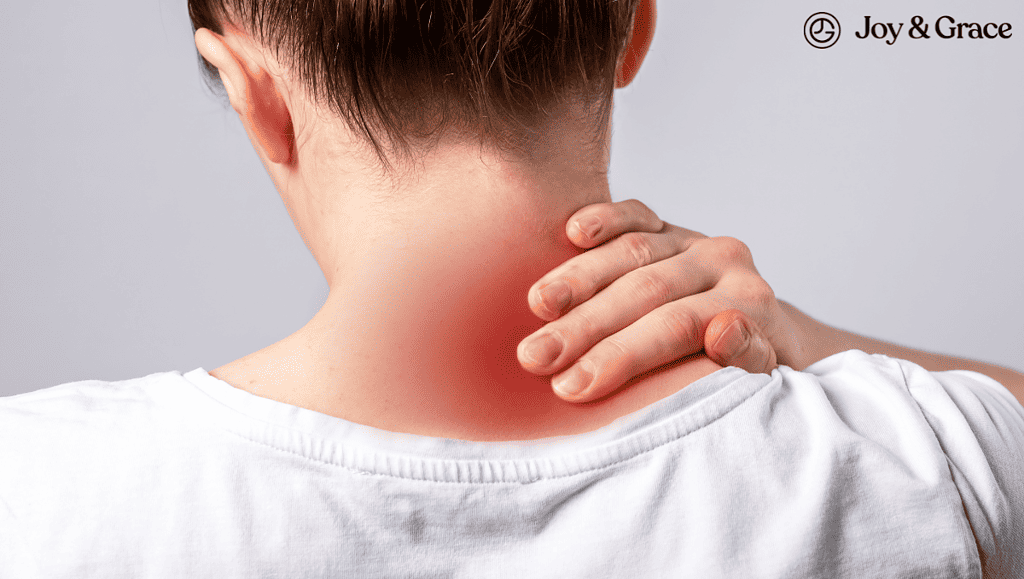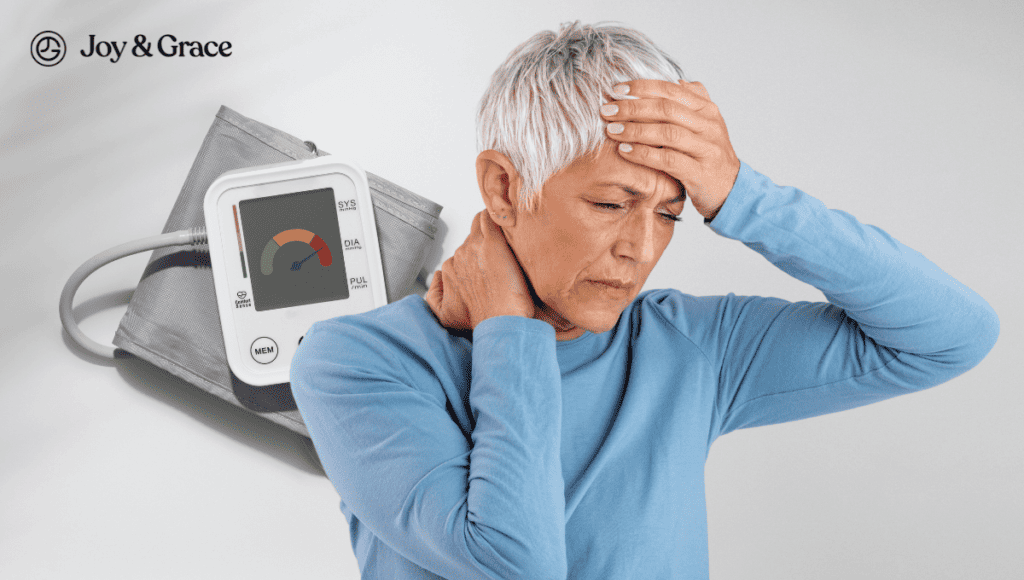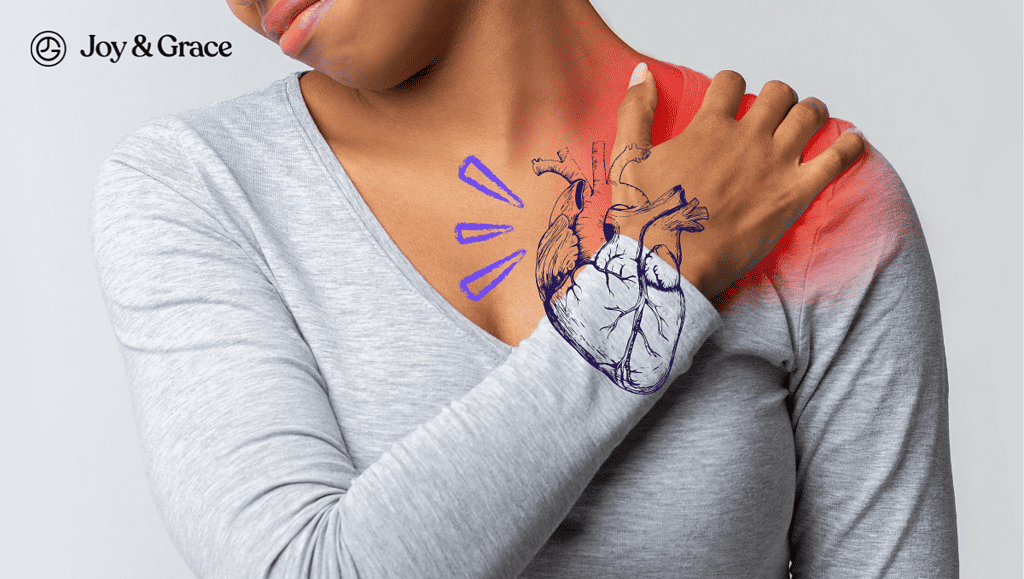Shoulder pain is a common complaint in our modern world. From athletes to office workers, anyone can fall victim to this pesky injury. One possible cause of shoulder pain is a torn labrum.
In this article, we'll delve into what a torn labrum is and provide some guidance for finding relief. So, let's uncover the secrets to ease the pain and get you back to living your life with more joy and grace!
What Is A Labrum Tear?
A labrum or labral tear is an injury to the soft tissue surrounding the socket of your shoulder joint, called the labrum. The labrum is a type of thick and rigid cartilage that helps keep your shoulder stable. It allows the upper arm bone to fit securely in the joint.
It’s important to note that a labrum tear can also occur in the hips. When a labrum tear occurs in the shoulder, it’s also called a glenoid labrum tear. When it occurs in the hips, it’s called an acetabular labrum tear.
What Are Common Causes Of A Shoulder Labral Tear?

A shoulder labral tear can occur due to several causes, including:
- Traumatic injury
This can be a direct blow to the shoulder or a fall onto an outstretched arm. It can also be due to a sudden jerking motion, such as when you're grabbing hold of something to avoid a fall or suddenly trying to lift a heavy object. All of these can cause a labral tear.
- Repetitive overhead motions
Repeated overhead activities can stress the shoulder joint and gradually wear down the labrum. Over time, this repetitive stress can lead to a labral tear. These activities include:
- Throwing a baseball
- Swinging a hammer
- Weightlifting
- Tennis or Badminton
- Volleyball
- Shoulder dislocation
The labrum can be damaged or torn when the shoulder joint is dislocated. The forceful displacement of the upper arm bone from the socket can cause significant stress on the labrum, resulting in a tear.
- Degenerative changes
The labrum can undergo natural degenerative changes with age, becoming weaker and more prone to tearing. Conditions like osteoarthritis can also accelerate wear and tear.
It's important to note that a combination of factors can contribute to a labral tear, and sometimes the exact cause may not be clear.
What Are The Types Of Labral Tears?
There are three main types of glenoid labral tears:
Bankart Tear
A Bankart tear is a labral tear in the shoulder joint's front part. It typically happens due to a shoulder dislocation, where the head of the upper arm bone (humerus) completely comes out of the shoulder socket. It can also be due to subluxation, where the head of the humerus partially comes out of the socket. This tear involves the labrum and surrounding ligaments, often resulting in shoulder instability.
Posterior Labral Tear
A posterior labral tear affects the shoulder joint's back part of the labrum. It can occur due to a traumatic injury, repetitive strain, or in combination with other shoulder injuries. Posterior tears are less common than anterior tears.
Slap Tear
SLAP stands for Superior Labrum Anterior to Posterior. A SLAP tear affects the upper (superior) part of the labrum, where the long head of the biceps tendon attaches. This type of tear can be caused by repetitive overhead motions or a sudden injury, such as falling on an outstretched arm.
What Are The Types Of SLAP Lesions?
There are four different types of SLAP lesions, each with varying severity and treatment options.
- Type 1 SLAP lesions
These involve a frayed (worn at the edge) or partially torn labrum but are still attached to the shoulder socket. This type of SLAP lesion is typically treated with conservative methods.
This type of SLAP may show signs of wear and tear but remains firmly attached to the glenoid (shoulder socket).
- Type 2 SLAP Lesions
Type II is the most common type of SLAP lesion. It is characterized by a superior labrum tear extending into the biceps tendon attachment. The labrum is completely detached from the shoulder socket and often requires surgery to repair the tear and reattach the labrum.
- Type 3 SLAP lesions
Type III SLAP lesions occur when the labrum is partially detached from the glenoid, but the biceps tendon remains intact. This type of tear leaves a loose flap of the labrum within the joint and is often called a “bucket-handle” tear.
- Type 4 SLAP lesions
Type IV SLAP lesions are the most severe and involve a tear in the superior labrum and an extension into the biceps tendon.
The labrum is detached from the glenoid, and the biceps tendon may have additional injuries or degeneration.
Is A SLAP Tear Worse Than A Rotator Cuff Tear?
A SLAP tear and a rotator cuff tear are two different types of injuries that affect the shoulder joint, and it's difficult to say which one is worse.
As for the pain levels, for instance, rotator cuff injuries often cause excruciating pain, especially at night. On the other hand, a SLAP tear can lead to dull, constant pain and a weaker shoulder.
That said, the severity and impact of these injuries can vary depending on several factors, including:
- The specific location of the injury
- The extent of the tear
- Your activity level and overall health
What Is The Most Common Symptom Of A Shoulder Labral Tear?
A torn shoulder labrum can come with a wide variety of symptoms. However, the most common symptoms are:
- A deep, aching pain in the shoulder
- Instability in the shoulder joint
- Decreased range of motion
- A grinding or locking sensation when moving your shoulder
Other possible symptoms include:
- Pain that moves down the arm
- Clicking or popping sound when moving the shoulder
- Shoulder pain even at rest or at night
It's important to remember that these symptoms can be present in various shoulder conditions. This further highlights the need for a thorough evaluation to diagnose a labral tear accurately.
Where Is Shoulder Labrum Pain Located?
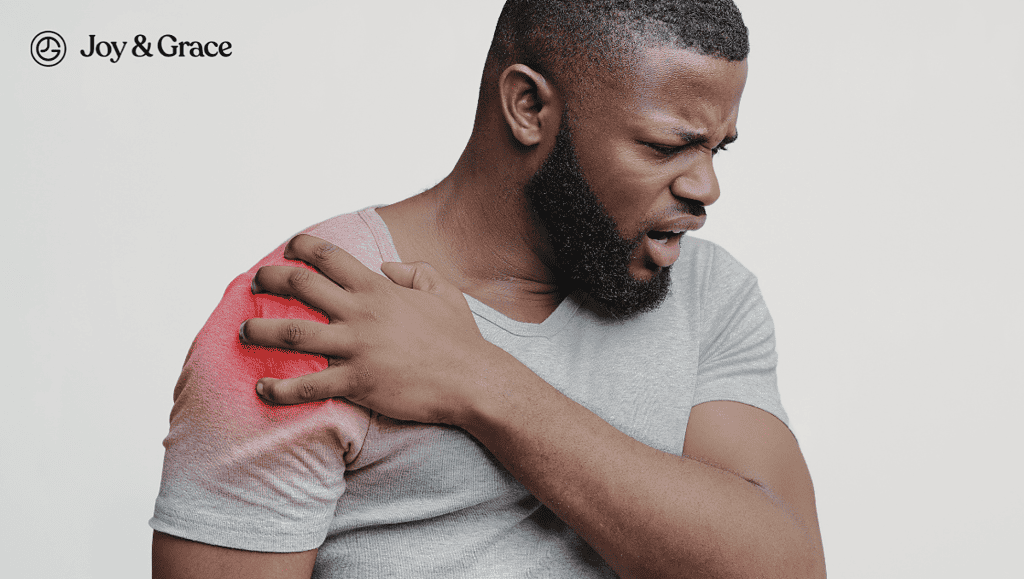
So, where is shoulder labrum pain located? Well, as we mentioned earlier, the location of the pain can depend on the type of labrum tear.
The shoulder joint is composed of three bones:
- The shoulder blade (scapula)
- The collarbone (clavicle)
- The upper arm bone (humerus).
The labrum is a ring of cartilage that surrounds the shoulder socket and holds the head of the humerus in place. Since the labrum has connections to the previously mentioned bones, pain from a torn labrum can be located in the following:
- Front and back of the shoulder
- Deep within the shoulder
- Upper arm, and
- Shoulder blade area
Can A Torn Shoulder Labrum Cause Neck Pain?
While some sources suggest that a shoulder labrum tear can cause neck pain, we found no studies that can support this claim.
How Do I Know If I Tore My Labrum In My Shoulder?
While the symptoms may tell you something’s wrong with your shoulder, they aren’t really enough to tell you that you have a torn labrum. Many shoulder conditions can present with the same symptoms.
If you suspect a torn labrum, consult a medical professional for a proper evaluation and diagnosis.
How Do I Test For A Torn Labrum?
A torn shoulder labrum is typically diagnosed through a combination of the following:
- Medical history assessment
Your healthcare provider will discuss your symptoms, prior injuries, and daily activities that may have contributed to the injury. They will also ask about any specific incidents or trauma that may have caused the tear.
During a physical examination, your doctor will evaluate your shoulder thoroughly. They may perform specific tests to assess the integrity of the labrum and other structures in the shoulder joint.
Here are some tests you can expect during a physical exam:
For this test, you will start by keeping your shoulder relaxed. Bend your elbow so your forearm is at a right angle, and turn your palm to face upwards. Make a fist with your hand.
The examiner will put their hand on your fist to prevent it from moving upward easily. They will ask you to imagine throwing an uppercut punch like a boxer, pushing your fist upward against their resistance.
While making this motion, the examiner will pay attention to any signs of discomfort or a painful popping feeling in your shoulder.
During this test, you will be asked to stand up. The examiner will position your arm, bent at a 90-degree angle and slightly brought closer to your body. Your arm will also be rotated inward so your thumb points toward the floor.
The examiner will place their hand on your elbow and ask you to resist their attempt to push your arm downwards. They will apply gentle pressure to see if you feel pain or discomfort.
After that, they will rotate your arm so that your palm faces upwards towards the ceiling. Then they will repeat the same motion of trying to push your arm downwards while you resist.
If you feel pain specifically at the joint during the first part of the test (with your thumb pointing down), it is considered a positive result. However, if you experience an improvement during the second part of the test (with your palm up), it is also considered a positive result.
To perform this test, you will stand up and place your hand of the affected arm on the same side of your hip, with your thumb pointing towards the back. The examiner will position one hand on your shoulder joint and the other on your elbow.
Next, the examiner will gently push on your elbow upwards to your shoulder joint in a diagonal direction.
During this process, the examiner will pay attention to any pain or uncomfortable clicking sensations.
You will lie on the exam table on your back, with your arms raised and supported by the table. Your palms should be facing upward.
The examiner will apply gentle pressure downward while asking you to simulate a throwing motion with your arm.
During this motion, the examiner will observe any signs of pain deep inside your shoulder joint or along the back of your shoulder.
You will stand up and raise your involved arm to a 90-degree angle at the elbow. Then, you will lift your arm out to the side, keeping it slightly forward and upward at an angle, reaching above 120 degrees.
The examiner will gently rotate your arm outward until they feel resistance. This is called terminal external rotation.
Next, the examiner will maintain the external rotation and move your arm horizontally away from your body. They will gradually lower it from 120 degrees to 60 degrees of abduction.
The test is positive if you have painful clicking or catching sensations along the back of your shoulder joint.
You will place the palm of your painful arm on the opposite shoulder, fingers spread out, and your elbow in front of your body.
The doctor will then try to pull your hand away from your shoulder while you resist their efforts.
The test result is considered positive if you can’t keep your hand against your shoulder and it moves away from the shoulder when the doctor pulls on it.
The examiner will position your arm with the elbow bent at a 90-degree angle. To test internal rotation, you will press the palm of your hand against your belly, bringing your elbow forward in front of your body.
Initially, the examiner will provide support for your elbow. The test is positive if your elbow can’t maintain its position in front of your body when the examiner removes their support.
Your arm will be supported against your trunk, and your elbow will be bent at a 90-degree angle, with your forearm turned so the palm faces downward.
The examiner will provide resistance while you try to rotate your forearm outward against their resistance. At the same time, the examiner will manually resist any inward rotation of your forearm.
The test is positive if you feel pain specifically over the front part of your upper arm, known as the bicipital groove. It’s also positive if you experience a sensation of your biceps muscle tendon partially moving out of place.
You will be asked to lift your arm forward while the examiner provides resistance. Your elbow should be slightly bent, and your forearm should be turned so the palm is facing upward.
A positive test result is when you feel pain in the front part of your upper arm when you lift your shoulder forward against the resistance.
- Imaging tests
These can include:
- Magnetic Resonance Imaging (MRI)
An MRI scan provides detailed images of the shoulder joint and surrounding soft tissues. It can help identify labral tears and assess their size, location, and severity.
According to a report, MRIs can detect SLAP lesions in up to 72% of asymptomatic middle-aged patients.
- Magnetic Resonance Arthrogram (MRA)
This test involves injecting a contrast dye into the shoulder joint before the MRI. The dye helps highlight the labrum and any associated tears more clearly.
- X-rays
While X-rays can't visualize labral tears, they are often performed to assess the bony structures of the shoulder joint. X-rays help detect signs of other conditions, such as bone spurs.
How Do I Fix Shoulder Labrum Pain?

There are non-surgical options considered as initial treatment or for less severe tears. Here are some non-surgical options for managing shoulder labrum pain:
- Rest and activity modification
Avoid activities that aggravate your shoulder pain and give your shoulder sufficient rest to allow the labrum to heal.
- Pain management
Anti-inflammatory medications, such as ibuprofen or naproxen, can help reduce pain and inflammation. Additionally, your doctor may recommend localized pain relief options such as ice packs or heat therapy.
- Physical therapy
Once pain is controlled, you can start a rehabilitation program to improve shoulder strength and endurance. Working with a physical therapist can help restore shoulder health and function. They can provide therapeutic exercises and stretches tailored to your condition to help relieve pain.
- Steroid injections
Corticosteroid injections may be used to alleviate pain and inflammation. These injections are administered into the shoulder joint with the help of imaging, such as ultrasound.
It's important to note that non-surgical options may not completely heal severe cases.
What Movements Should I Avoid With Shoulder Labral Tear?
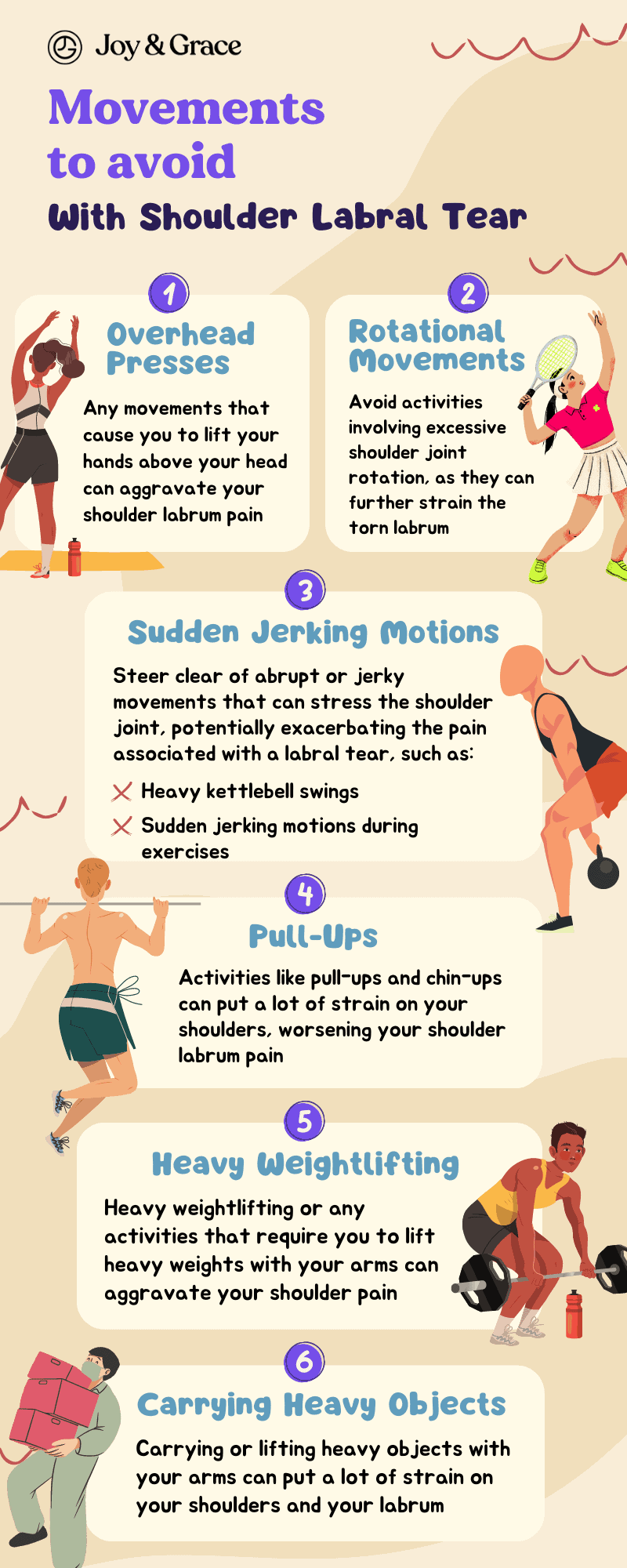
If you're suffering from a torn labrum shoulder pain, it's essential to avoid certain movements that can worsen it. Here are some movements you should avoid:
- Overhead Presses
Any movements that cause you to lift your hands above your head can aggravate your shoulder labrum pain. Overhead presses or any other overhead movements should be avoided. - Rotational Movements
Avoid activities involving excessive shoulder joint rotation, as they can further strain the torn labrum. Examples include:
- Throwing motions
- Engaging in sports that require repetitive rotational shoulder movements like tennis or baseball.
- Sudden Jerking Motions
Steer clear of abrupt or jerky movements that can stress the shoulder joint, potentially exacerbating the pain associated with a labral tear. This includes activities like:
- Heavy kettlebell swings
- Sudden jerking motions during exercises
- Pull-Ups
Activities like pull-ups and chin-ups can put a lot of strain on your shoulders, worsening your shoulder labrum pain.
- Heavy Weightlifting
Heavy weightlifting or any activities that require you to lift heavy weights with your arms can aggravate your shoulder pain.
- Carrying Heavy Objects
Carrying or lifting heavy objects with your arms can put a lot of strain on your shoulders and your labrum. To avoid a torn shoulder labrum pain location, avoid carrying or lifting.
Can I Still Workout With A Torn Labrum?
Well, it depends on the severity of your injury and the types of exercises you're doing. Some exercises should be avoided when you have a torn labrum. Any movements that involve lifting your arm over your head. This means you'll need to steer clear of exercises like overhead presses, pull-ups, and bench presses.
However, not all hope is lost. You can still do plenty of safe exercises to stay in shape. Low-impact exercises like walking or swimming can help you stay active without putting too much strain on your shoulder. You can also try strength training exercises focusing on other areas of your body, such as your legs or core.
Some exercises can also help in the recovery process. We have a list of them here.
If you’re an athlete and have undergone surgery, you can return to doing sports-related exercises 3 months after the procedure.
It's always a good idea to consult your doctor or physical therapist before starting or changing your exercise routine.
Can A Shoulder Labral Tear Heal Without Surgery?
In some cases, tears can heal independently with proper care and conservative treatment, while surgery may be necessary in other cases.
According to Dr. Stephen Fealy, MD, "If physical therapy fails and the athlete still can’t complete overhead motions, or the shoulder continues to dislocate, surgical treatment might be required to reattach the torn ligaments and labrum to the bone."
Arthroscopic surgery repair is a commonly used surgical procedure for treating shoulder labrum tears. Compared to open surgery, arthroscopic repair offers shorter recovery times and reduced pain. Open surgery involves larger incisions and more extensive tissue disruption.
How Long Does A Labral Tear Take To Stop Hurting?
If you underwent arthroscopic repair, you can expect a smoother recovery process. But if you underwent open surgery, you may experience more postoperative pain and require a longer recovery period.
The timeline for full recovery can vary for athletes recovering from shoulder labrum surgery.
It generally takes around six months to one year for athletes to fully recover. The recovery process may be the longest among overhead athletes. This is due to the demands placed on the shoulder during their sport.
Regardless of the surgical approach, most athletes will be advised to wear a sling for 2 to 6 weeks after surgery. This sling provides support and helps protect the healing shoulder during the initial stages of recovery.
A rehabilitation program with a physical therapist will follow after this rest period.
Can You Fully Recover From A Labrum Tear?
According to Dr. Stephen Fealy, MD, "If fixed properly, most athletes should be able to return to at least 80 percent of their pre-injury level of play."
Meanwhile, in a study, 71% of all athletes regained their level of function prior to labral injury. However, according to the same study, only 66% of overhead athletes successfully returned to their sport at the same or higher level following shoulder labrum surgery.
How Serious Is A Torn Shoulder Labrum?
When you have a torn shoulder labrum, the severity can vary depending on the extent and location of the tear. Generally, a torn labrum can significantly impact your shoulder function and overall quality of life. It can cause persistent pain and difficulty with daily activities and sports participation.
If left untreated, a torn shoulder labrum can lead to:
- Recurrent dislocations
- Chronic pain
- Joint degeneration
Takeaway
A torn labrum shoulder pain can be a debilitating condition that affects many individuals. The labrum is a cartilage ring that stabilizes the shoulder joint, and when it tears, it can cause intense discomfort and a limited range of motion. If you suspect a torn labrum, seeking medical attention for an accurate diagnosis is crucial.
